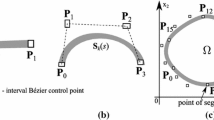Abstract
Estimating closed curves based on noisy data has been a popular and yet a challenging problem in many fields of applications. Yet, uncertainty quantification of such estimation methods has received much less attention in the literature. The primary challenge stems from the fact that the parametrization of a closed curve is not generally unique and hence popular curve fitting methods (e.g., weighted least squares based on known parametrization) does not work well due to initialization instabilities leading to larger uncertainties. First, an initial set of cluster points are obtained by means of a constrained fuzzy c-means algorithm and an initial curve is constructed by fitting a B-spline curve based on the cluster centers. Second, a novel tuning parameter selection procedure is proposed to obtain optimal number of knots for the B-spline curve. Experimental results with simulated noisy data show that the proposed method works well for a variety of unknown closed curves with sharp changes of slopes and complex curvatures, even when moderate to large noises are added with heteroskedastic errors. Finally, a new curvature preserving uncertainty quantification method is proposed based on an adaptation of bootstrap method that provides confidence band around the fitted curve, an aspect that is rarely provided by popular curve fitting methods.









Similar content being viewed by others
References
Bauer M, Bruveris M, Harms P, Møller-Andersen J (2015) Curve matching with applications in medical imaging. In: In 5th MICCAI workshop on mathematical foundations of computational anatomy
Bezdek JC (2013) Pattern recognition with fuzzy objective function algorithms. Springer, Berlin
Björck Å (1996) Numerical methods for least squares problems. Society for Industrial and Applied Mathematics, Philadelphia
Blake A, Isard M (1998) Active contours. Springer, Berlin
Bo P, Gongning L, Kuanquan W (2016) A graph-based method for fitting planar B-spline curves with intersections. J Comput Des Eng 3:14–23
Burchard HG (1974) Splines (with optimal knots) are better. Appl Anal 3:309–319
Carnicer JM, Pena JM (1993) Shape preserving representations and optimality of the Bernstein basis. Adv Comput Math 1:173–196
Farin G (1997) Curves and surfaces for computer aided geometric design: a practical guide, 4th edn. Academic Press, New York
Furferi R, Governi L, Palai M, Volpe Y (2011) From unordered point cloud to weighted B-spline—a novel PCA-based method. Appl Math Comput Eng Am Conf Appl Math 11:146–151
Hoschek J, Lasser D, Schumaker LL (1993) Fundamentals of computer aided geometric design. AK Peters Ltd, Natick
Iglesias A, Galvez A, Collantes M (2017) Multilayer embedded bat algorithm for B-spline curve reconstruction. Integr Comput-Aided Eng 24:385–399
Lee ET (1989) Choosing nodes in parametric curve interpolation. Comput-Aided Des 21:363–370
Lee In-Kwon (2000) Curve reconstruction from unorganized points. Comput Aided Geom Des 17:161–177
Ma WY, Kruth JP (1998) NURBS curve and surface fitting for reverse engineering. Int J Adv Manuf Technol 14:918–927
Rogers DF, Fog NR (1989) Constrained B-spline curve and surface fitting. Comput-Aided Des 21:641–648
Sarkar B, Menq CH (1991) Smooth-surface approximation and reverse engineering. Comput-Aided Des 23:623–628
Speer T, Kuppe M, Hoschek J (1998) Global reparametrization for curve approximation. Comput Aided Geom Des 15:869–877
Sabsch T, Braune C, Dockhorn A, Kruse R (2017) Using a multiobjective genetic algorithm for curve approximation. In: 2017 IEEE symposium series on computational intelligence (SSCI), pp 1–6
Sarkar B, Menq CH (1991) Parameter optimization in approximating curves and surfaces to measurement data. Comput Aided Geom Des 8:267–290
Wang W, Pottmann H, Liu Y (2006) Fitting B-spline curves to point clouds by curvature-based squared distance minimization. ACM Trans Graph 25:214–238
Yan H (2001) Fuzzy curve-tracing algorithm. IEEE Trans Syst Man Cybern Part B Cybern 31:768–780
Yang H, Wang W, Sun J (2004) Control point adjustment for B-spline curve approximation. Comput Aided Des 36:639–652
Yang XS, Gandomi AH (2012) Bat algorithm: a novel approach for global engineering optimization. Eng Comput 29:464–483
Zhang TY, Suen CY (1984) A fast parallel algorithm for thinning digital patterns. Commun ACM 27:236–239
Zhao X, Zhang C, Yang B, Li P (2011) Adaptive knot placement using a GMM-based continuous optimization algorithm in B-spline curve approximation. Comput-Aided Des 43:598–604
Zheng W, Bo P, Liu Y, Wang W (2012) Fast B-spline curve fitting by L-BFGS. Comput Aided Geom Des 29:448–462
Acknowledgements
The authors are grateful to the two anonymous reviewers and an associate editor for their valuable comments and constructive suggestions, which have led to a significant improvement of an earlier version of this manuscript.
Author information
Authors and Affiliations
Corresponding author
Additional information
Publisher's Note
Springer Nature remains neutral with regard to jurisdictional claims in published maps and institutional affiliations.
Supplementary Information
Below is the link to the electronic supplementary material.
Rights and permissions
About this article
Cite this article
Chen, L., Ghosh, S.K. Uncertainty quantification and estimation of closed curves based on noisy data. Comput Stat 36, 2161–2176 (2021). https://doi.org/10.1007/s00180-021-01077-4
Received:
Accepted:
Published:
Issue Date:
DOI: https://doi.org/10.1007/s00180-021-01077-4




